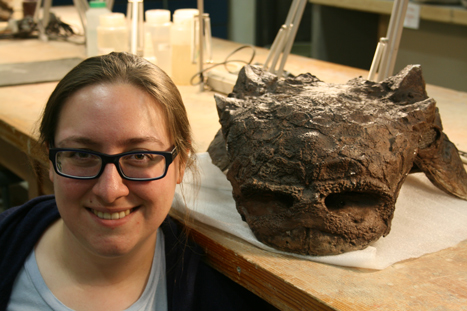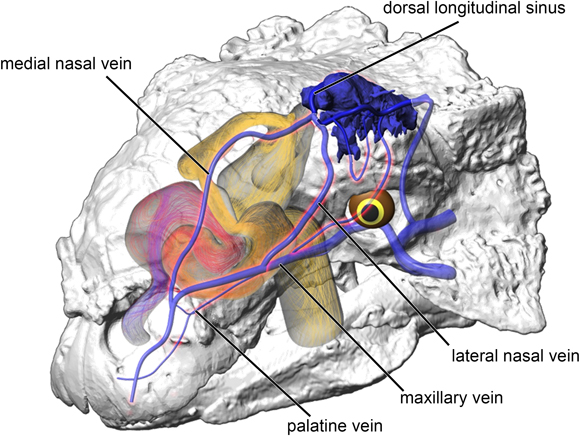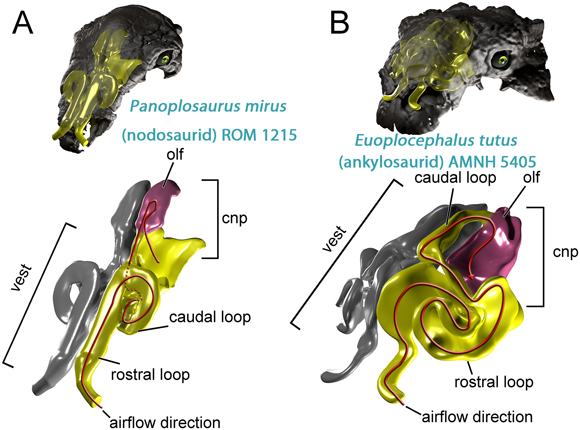Armoured Dinosaurs Coped with the Mesozoic Heat Thanks to Nasal Air-conditioning
Being a very large dinosaur covered in armour, might help you to keep safe from attack by predatory dinosaurs, but this body plan does have its downsides. For example, how do you keep cool when you have a very broad body? New research from scientists based at Ohio University and the New York Institute of Technology College of Osteopathic Medicine at Arkansas State, suggests that those complicated Ankylosauria nasal passages acted like heat-exchanges helping to prevent these dinosaurs from overheating.
In essence, this study published in the academic, on-line journal PLOS One, suggests that members of the Ankylosauria clade had built-in air conditioning units in their noses.
Convoluted Nasal Passages Helped Armoured Dinosaurs to Avoid Overheating
Picture credit: PLOS One with additional annotation from Everything Dinosaur
Panoplosaurus and Euoplocephalus Studied
The researchers, which included Jason Bourke (Assistant Professor at the New York Institute of Technology College of Osteopathic Medicine at Arkansas State), chose to examine the craniums of Euoplocephalus (E. tutus), a member of the Ankylosauridae family of dinosaurs along with the nodosaurid Panoplosaurus mirus. A representative of the Nodosauridae family as well as a member of the Ankylosauridae was selected as nodosaurs tend to have much narrower muzzles than the related ankylosaurs. In this way, the scientists were able to compare and contrast the different nasal passages associated with these two types of armoured dinosaur.
Assistant Professor Bourke commented:
“The huge bodies that we see in most dinosaurs must have gotten really hot in warm Mesozoic climates. Brains don’t like that, so we wanted to see if there were ways to protect the brain from cooking. It turns out the nose may be the key.”
Dr Victoria Arbour, an Authority on the Ankylosauria Poses Next to the Broad Skull of Euoplocephalus (E. tutus)

Picture credit: Angelica Torices
Computational Fluid Dynamic Analysis
The research team created three-dimensional, computer generated models of two famous skull fossils, a Panoplosaurus specimen housed in the Royal Ontario Museum collection and a Euoplocephalus skull from the American Museum of Natural History (New York). A computational fluid dynamic analysis was then undertaken to map how air would have moved through the nasal passages as these dinosaurs breathed. The scientists wanted to test the heat exchange capacity of the complex passages, to see how well the Ankylosauria noses transferred heat from the body to the inhaled air.
Co-author of the study, Lawrence Witmer (Ohio University), explained:
“A decade ago, my colleague Ryan Ridgely and I published the discovery that ankylosaurs had insanely long nasal passages coiled up in their snouts. These convoluted airways looked like a kid’s ‘crazy-straw!’ It was completely unexpected and cried out for explanation. I was thrilled when Jason took up the problem as part of his doctoral research in our lab.”
Heat Exchangers
It is thought that these complex nasal passages gave members of the Ankylosauria clade, an exceptional sense of smell. This may have been their primary function, however, noses are also heat exchangers, ensuring that air is warmed and humidified before it reaches the delicate lungs. To accomplish this effective air conditioning, birds and mammals, including humans, rely on thin curls of bone and cartilage within their nasal cavities called turbinates, which increase the surface area, allowing for air to come into contact with more of the nasal walls. Ankylosaurs and nodosaurids lacked turbinates, to compensate for this they evolved exceptionally long and twisty nasal passages.
Comparing Armoured Dinosaurs to Living Animals
When the researchers compared their findings to data from living animals, such as the nasal passages of an avian dinosaur (pigeon), they discovered that the noses of armoured dinosaurs were just as efficient at warming and cooling respired air. The length of the winding and twisting nasal passages in the two armoured dinosaurs studied were also measured. In the narrow-snouted, nodosaurid Panoplosaurus, the nasal passages were a bit longer than the skull itself and in Euoplocephalus they were almost twice as long as the skull, which is why they are coiled up in the snout.
To see if nasal passage length was the reason for this efficiency in heat exchange, the researchers created alternative models with shorter, simpler nasal passages that ran directly from the nostril to the throat, as in most other animals. The results clearly showed that nose length and the length of the nasal passages were indeed key to their air-conditioning ability.
Assistant Professor Bourke stated:
“When we stuck a short, simple nose in their snouts, heat-transfer rates dropped over fifty percent in both dinosaurs. They were less efficient and didn’t work very well.”
Helping to Cool Brains
The blood vessels in the skull leading up to and surrounding the brain were mapped. The scientists wanted to explore whether the internal plumbing of the snout helped to cool the brains of armoured dinosaurs. The team found a rich blood supply running adjacent to the convoluted nasal passages.
Co-author Ruger Porter (Ohio University), explained:
“When we reconstructed the blood vessels, based on bony grooves and canals, we found a rich blood supply running right next to these convoluted nasal passages. Hot blood from the body core would travel through these blood vessels and transfer their heat to the incoming air. Simultaneously, evaporation of moisture in the long nasal passages cooled the venous blood destined for the brain.”
Euoplocephalus Kept a Cool Head

Picture credit: PLOS One
Thermoregulation – A Problem for Large Animals
The large, broad bodies of Panoplosaurus and Euoplocephalus were really good at retaining heat, which might have some advantages, especially when you need to stay warm, but this does cause problems when large tetrapods need to keep their cool. This heat-shedding problem would have put them at risk of overheating even on cloudy days. In the absence of some protective mechanism, the delicate neural tissue of the brain could be damaged by the hot blood from the body core. In simple terms, the small brains of armoured dinosaurs might have been cooked inside the skull.
The complicated nasal airways of these dinosaurs were acting as radiators to cool down the brain with a constant flow of cooled venous blood. This natural engineering feat also may have allowed some members of the Dinosauria to evolve into huge animals.
Lawrence Witmer added:
“When we look at the nasal cavity and airway in dinosaurs, we find that the most elaborate noses are found in the large dinosaur species, which suggests that the physiological stresses of large body size may have spurred some of these anatomical novelties to help regulate brain temperatures.”
For models and replicas of armoured dinosaurs and other prehistoric animals: Dinosaur and Prehistoric Animal Figures.







Leave A Comment